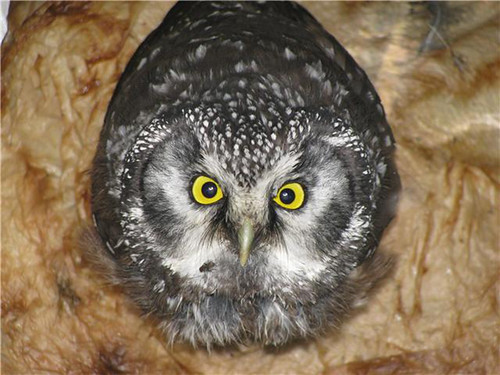
Small owls, such as western screech and northern saw whet owls, weigh between 3 and 7 ounces, or about the same weight as a small cell phone or a deck of cards.
They prefer dark, narrow spaces for nesting and roosting, which is why they are called cavity birds. Their habitat preferences make them prone to using man-made features, such as open pipes, that mimic their natural nesting and roosting cavities. But on some public lands, that natural act of finding habitat in ventilation pipes has led to their death.
The resolution that could save thousands of birds resulted in an award from Wings Across the Americas, a program of the U.S. Forest Service and its partners to conserve birds, bats, butterflies and dragonflies across all landscapes and boundaries. The project received the Habitat Management and Partnership Award, shared with Forest Service employees and the Teton Raptor Center in Jackson Hole, Wyo.
Many public agencies use vault toilets to manage sanitary waste on their lands, and the ventilation pipes seem to attract the birds. The small owls enter the hole at the top of the vent, fall down the vertical pipe and land in the waste holding reservoir. The small size and weight of the birds make it impossible for them to gain any lift to escape.
In 2011, the Teton Raptor Center heard about the problem and decided to do something.
Roger Smith, founder of Teton Raptor Center, said a photo of an owl peering up from the reservoir made him realize the need for “…a real, tangible conservation project that people could understand and commit to – preventing bird mortality from a man-made problem by covering the hole with a screen.”
As a non-profit organization with a mission focused on conservation, education and rehabilitation, the Teton Raptor Center resolved to launch a public awareness campaign: the Port-O-Potty Owl Project. Of course, it quickly gained the nickname “Poo-Poo Project.”
Unbeknownst to Smith was the collaboration between Gerardo Chavarria, a Forest Service regional engineer based in Denver, and Greg Hayward, an agency wildlife ecologist working in Alaska. Hayward sought out Chavarria because he wanted an engineering fix to prevent the bird deaths.
“His concern was contagious and provided a challenge for me to investigate if there was a cost effective way to screen the toilet vent stacks without too much negative effect on air flow out of the stacks.” he said.
Chavarria used his engineering skills to design a screen that would not adversely affect the functional design of a vault toilet. In fact, his work helped to advance the quick fixes the raptor center sought on vault toilets on three national forests in Wyoming. Chavarria’s advance research determined the types of screen that would work, which allowed the raptor center and the Forest Service to immediately cap the toilet vents.
Because the need and resolution were already pre-determined, Forest Service employees Joe Harper of the Shoshone National Forest, Tammy Fletcher of the Caribou-Targhee National Forest and Bernadette Barthelenghi of the Bridger-Teton National Forest could more quickly answer the raptor center’s call.
Harper brought the awareness of what happened to the birds to the forest, and all vault toilets are now screened and any new toilets and pipes also will be screened. Fletcher helped to secure grant funding to purchase screens for the Caribou-Targhee and all participating land agencies within the Greater Yellowstone Ecosystem. And Barthelenghi made the work possible on her forest and worked to ensure the project and solution were shared with all agency offices.
Joe Alexander, forest supervisor on the Shoshone, said they partnered with community organizations to help install the necessary screens. Local chapters of the Audubon Society and Boy Scouts engaged on this real world problem and helped to make a difference.
“The Shoshone National Forest prides itself on being the leader in conservation,” Alexander said. “After implementation of these new toilets it became apparent that some small efforts could go a long ways in protecting our avian resources.
The Wings Across the Americas awards were presented March 12 during the 79th North American Wildlife and Natural Resources Conference. Other award winners are:
- The Barto Fen Restoration Project on the Mark Twain National Forest in Missouri received the first Dragonfly Conservation Award for one of the largest and most genetically diverse populations of this dragonfly.
- The Monitoring and Conservation of Black-Backed Woodpecker in Burned Forests project received the Research Management & Partnership award. Since 2008, several organizations, including the Pacific Southwest Regional Office of the U.S. Forest Service and the Institute for Bird Populations, worked to better integrate the habitat needs of the bird into forest management plans.
- The Bat Cave Gating Project on the Mark Twain National Forest also received the Bat Conservation Award. The forest is home to a large gray bat maternity colony, and the project’s goal is to protect the bats by closing nearby trails and installing chute gauges and flyover gates at entrances of bat maternity caves.
- The Migratory Shorebird Project: Connecting Communities of the Americas through Research for Conservation received the International Cooperation Award. The project looks at two species, the Western Sandpiper and the Pacific population of the Dunlin, measures their response to management actions, studies what influence population changes and educates people on the importance of wetland resources all along the Pacific Coast of the Americas.
- The University of Minnesota Monarch Lab received the Communities in Conservation award. For more than 20 years, the lab has linked academic research with community outreach programs associated with monarch conservation.
